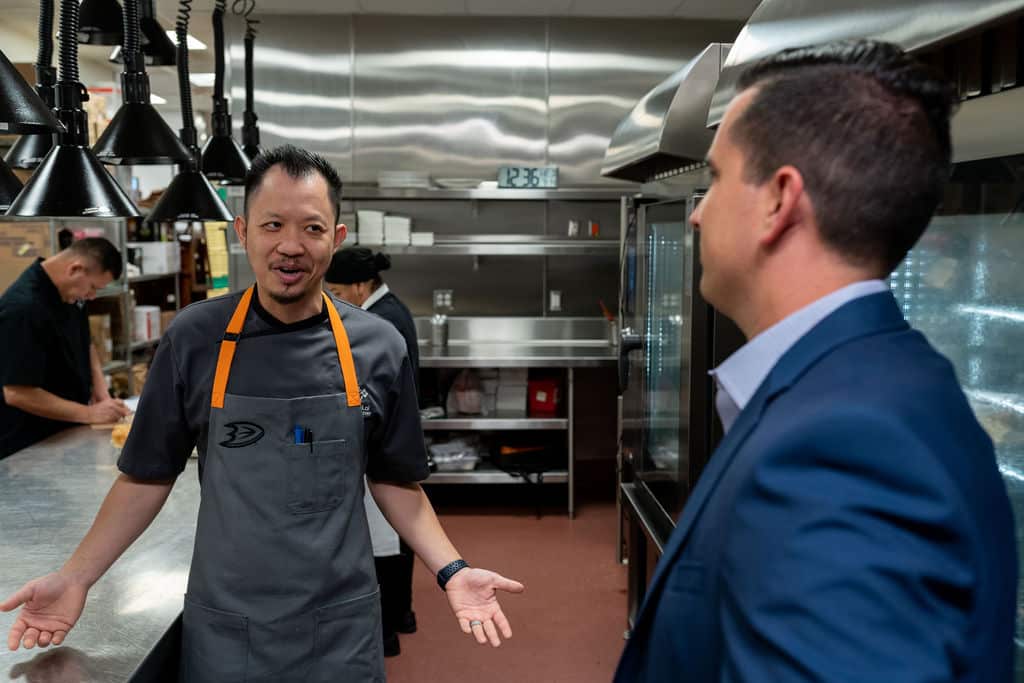While there is no one size fits all for what each manufacture requires, food brokers are typically responsible for 3 things:
- Introduce New Product Innovation
- Report Market Intelligence
- Achieve the Sales Plan
Does it make financial sense for foodservice manufactures to partner with food brokers?
The cost of making a sales call is at an all-time high. From putting fuel in the car, to labor, to travel, and beyond, employing a direct sales force in every market throughout the country can be costly.
Working with a foodservice broker is usually a more cost-efficient way to scale sales and marketing efforts. For technical purposes, food brokers fees will usually be built in to “Cost of Goods” on a Profit & Loss Statement, whereas a direct sales force falls lower on the P&L under the “Expense” column.
Rather than carry the fixed overhead costs of a direct sales force, the broker fee is built into the price of the manufacture’s products. This is a mitigation measure too. If sales decrease – as seen during the pandemic – the broker fee will decrease in conjunction.
So WHAT does a food broker actually do?
1. Introduce New Product Innovation
Manufactures must consistently find ways to increase profits and they can do so by producing new, innovative items.
However, production is only one part of the game of business.
Like a fish needs water, foodservice manufactures need the pull through at both the Operator and Distributor level to increase production and therefore, profitability too.
This is where the Foodservice Broker comes in. In a coordinated effort, foodservice manufactures can train and educate their broker sales force on the features and benefits of their new, innovative products. In turn, the broker can communicate that message to their base of operator and distributor partners with the objective to grow sales.
As the local market experts, brokers will handle everything from product cuttings, to price negotiation, to ensuring the product gets properly stocked in distribution. Foodservice sales is more of a slow moving vessel that soaks up a lot of time and money. It’s on the broker to absorb the costs of introducing new innovation and they do so by leveraging their portfolio of brands.
For example, in California, a manufacture could reasonably make 1 sales presentation for about $400; this includes: labor, travel, and other variable expenses. For a broker, they can syndicate that same call by leveraging multiple brands and products, thus reducing the overall cost from let’s say, $400 to $100/brand.
In return, the broker is compensated in perpetuity on the sale and the manufacture increases profitability, creating a win-win scenario.
2. Report Market Intelligence
Communication is what makes the foodservice world go round.
At Portillo Sales & Marketing, we cover both California and Nevada, yet what a difference a 1-hour drive can make in the overall consumer profile in a local area. As the pandemic taught, rules and ideologies can vary greatly county-to-county. Communicating local market intelligence on a consistent basis is the crux for success in foodservice sales.
Brokers typically use a CRM Tool to database their daily sales results and those can be utilized by the manufacture to make accurate predictions and decisions. Often, the manufacture doesn’t live within a local market and thus rely on the broker to relay market intelligence.
For example, the consumer makeup in Los Angeles is completely different than that of Birmingham. The customer needs are anything but the same, so it is on the broker to council the manufacture on what they are experiencing locally so that they can cater their marketing message, pricing, etc. to the demands of the market.
3. Achieve the Sales Plan
Isn’t that what we all want?
A foodservice broker wears many hats and they face competing priorities on a daily basis, yet must keep the main goal, the main goal: achieve the sales plan.
Manufacture’s expectations vary greatly from one to another, so it’s important for the broker to receive clear direction and a mutually-agreed upon plan to execute. Sales plans can be as basic or complex as you’d like, but a good guide follows something like this:
- Communicates mutually-agreed upon objectives
- Details the roles of the broker and how the manufacture can support
- Allows the broker to work strategically
- Sets metrics to analyze Key Performance Indicators at the conclusion of the specified time period
At Portillo, we focus on calling on the larger, Strategic Accounts that can move the sales needle. We then can enter that sales data into our CRM system and measure it against our objectives to assess sales plan achievement. In everything we do, we strive for 100% achievement.
The very best,
Nick Portillo
In case you missed it, make sure to check out my last post on the 3 Ways to Maximize Work-With ROI. In a sales driven world, it pays to get work-with’s right.
Related Posts
-
March 10, 2023
Innovative Marketing Strategies – Booths That Caught My Eye at Expo West
As a player in the foodservice industry, attending Expo West in Anaheim is a refreshing change of...
Read More -
December 13, 2022
How to Manage a Food Broker: 3 Tips Every Manufacturer Should Do
As a foodservice broker, our manufacture clients occasionally ask, “What do other manufacturers do that...
Read More -
November 9, 2022
3 Ways to Maximize Work-With ROI
Visiting customers with your broker and distributor partners is a great way to get brand...
Read More





